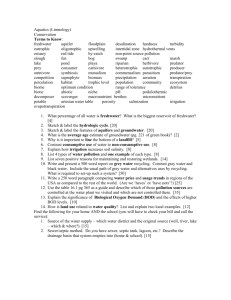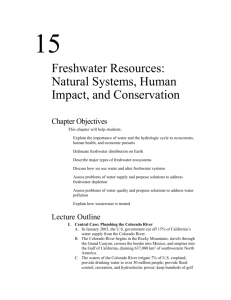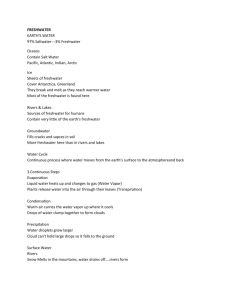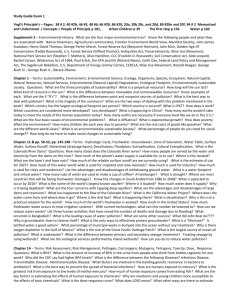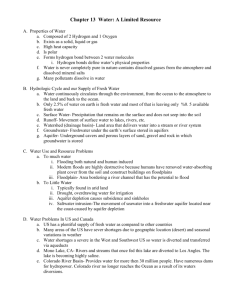Outline and Resources for Chapter 15
advertisement
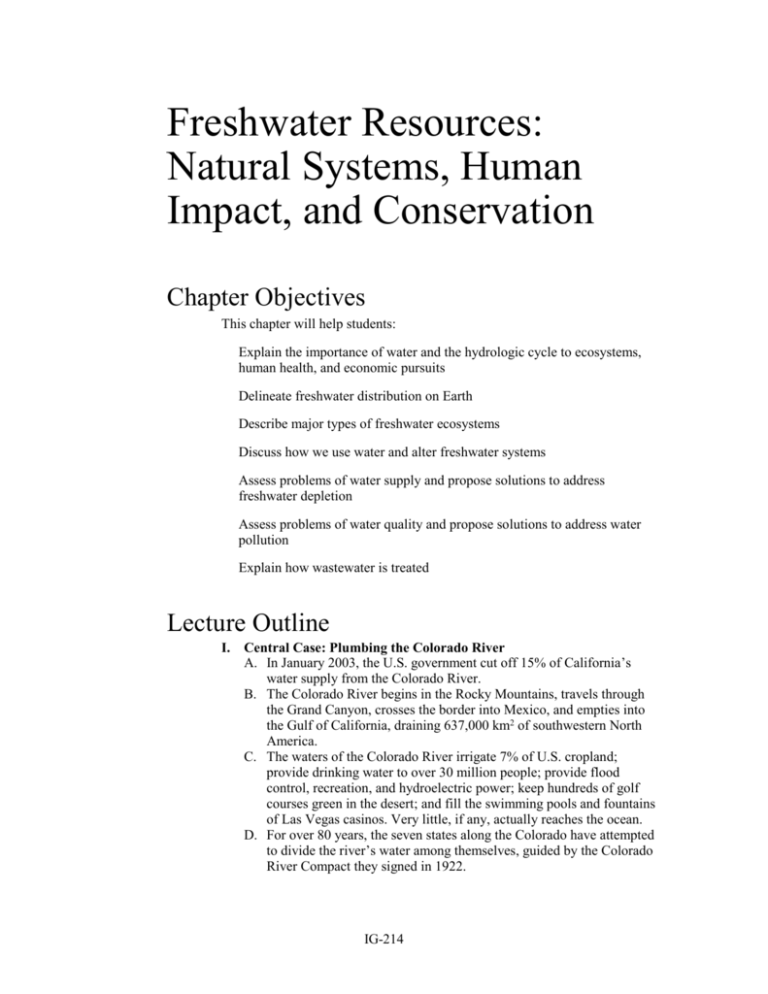
Freshwater Resources: Natural Systems, Human Impact, and Conservation Chapter Objectives This chapter will help students: Explain the importance of water and the hydrologic cycle to ecosystems, human health, and economic pursuits Delineate freshwater distribution on Earth Describe major types of freshwater ecosystems Discuss how we use water and alter freshwater systems Assess problems of water supply and propose solutions to address freshwater depletion Assess problems of water quality and propose solutions to address water pollution Explain how wastewater is treated Lecture Outline I. Central Case: Plumbing the Colorado River A. In January 2003, the U.S. government cut off 15% of California’s water supply from the Colorado River. B. The Colorado River begins in the Rocky Mountains, travels through the Grand Canyon, crosses the border into Mexico, and empties into the Gulf of California, draining 637,000 km2 of southwestern North America. C. The waters of the Colorado River irrigate 7% of U.S. cropland; provide drinking water to over 30 million people; provide flood control, recreation, and hydroelectric power; keep hundreds of golf courses green in the desert; and fill the swimming pools and fountains of Las Vegas casinos. Very little, if any, actually reaches the ocean. D. For over 80 years, the seven states along the Colorado have attempted to divide the river’s water among themselves, guided by the Colorado River Compact they signed in 1922. IG-214 1. California has been permitted to exceed its allotment because the other states did not use their full shares. 2. In 2000, the federal government pressured California to lower its usage by about 15%, gradually over 15 years. 3. By 2007, the reservoirs were only half full and the seven states were forced to revisit the agreement. E. Several states sought variances in the amount of entitled water due to continued drought conditions and predicted droughts. 1. California worked hard to get agricultural districts, which controlled most of the water, to sell part of their shares, but the Imperial Irrigation District backed out. 2. In 2007, Las Vegas chose a controversial plan to mine groundwater from below the scenic Great Basin desert. Critics fear the plan will undermine the fragile desert ecology of the region. 3. With growing human population, the western desert states will continue to challenge the capacity of water districts in that region. II. Freshwater Systems A. Of all the water on Earth, only 2.5% is considered freshwater. Most of that is tied up in glaciers and ice caps. B. Water moves in the hydrologic cycle. C. Rivers and streams wind through landscapes. 1. Bodies of actively flowing water comprise one major class of freshwater ecosystem. 2. As streams flow downhill, they join one another and eventually form larger water channels, or rivers. 3. Due to their size and power, rivers shape the landscape through which they run. 4. A river may shift its course over time; areas that are periodically flooded are within the floodplain. D. Lakes and ponds are also ecologically diverse systems. 1. The region ringing the edge of a water body is the littoral zone. 2. The bottom of a lake or pond is the benthic zone. 3. The shallow waters away from shore are termed the limnetic zone, where light enters and supports phytoplankton, which in turn supports zooplankton. 4. Deeper in open water, where the sunlight does not reach, is the profundal zone, which lacks plant life. E. Wetlands include marshes, swamps, and bogs. 1. Systems that combine elements of freshwater and dry land are enormously rich and productive. 2. All types of wetlands are extremely valuable to wildlife, and all types have been extensively drained and filled, largely for agriculture. F. Groundwater plays key roles in the hydrologic cycle. 1. Groundwater is contained in aquifers—porous, spongelike formations of rock, sand, or gravel that hold water. 2. The water table is the boundary between the upper layer, or zone of aeration, and the lower layer, or zone of saturation, which is completely filled with water. IG-215 3. There are two broad categories of aquifers—confined aquifers, also known as artesian aquifers, which are under pressure, and unconfined aquifers. G. Water is unequally distributed across Earth’s surface. III. How We Use Water A. Water supplies our households, agriculture, and industry. 1. Most uses of water are consumptive use, in which water is removed from a particular body of water and is not returned to it. 2. Nonconsumptive use of water does not remove, or only temporarily removes, water from an aquifer or surface water body. B. Inefficient irrigation wastes water. C. We are depleting groundwater. 1. Sometimes as aquifers lose water, the substrate becomes weaker, and subsidence occurs, locally and suddenly, in the form of sinkholes. D. We divert—and deplete—surface water to suit our needs. E. Will we see a future of water wars? 1. Many predict that water’s role in regional conflicts will increase as human population continues to grow in water-poor areas. F. Dikes and levees are meant to control floods. G. We have erected thousands of dams. H. China’s Three Gorges Dam is the world’s largest. I. Some dams are now being removed. 1. By removing dams and letting rivers flow free, we can restore riparian ecosystems, reestablish economically valuable fisheries, and reintroduce river recreation. 2. Many dams have aged and are in need of costly repairs or have outlived their economic usefulness. IV. Solutions to Freshwater Depletion A. Solutions can address supply or demand. B. Desalination “makes” more freshwater. 1. The best-known technological approach to generate freshwater is desalination, or desalinization—the removal of salt from seawater or other water of marginal quality. 2. One method of desalination mimics the hydrologic cycle by hastening evaporation from allotments of ocean water with heat and then condensing the vapor—essentially distilling freshwater. 3. Another method involves forcing water through membranes to filter out salts; the most common process is called reverse osmosis. C. Agricultural demand can be reduced. 1. Farmers can use technology to improve efficiency in a number of ways, including lining irrigation canals to prevent leaks and leveling fields to minimize runoff. 2. Techniques to increase irrigation efficiency include low-pressure spray irrigation, which sprays water downward toward plants, and drip irrigation systems, which target individual plants and introduce water directly onto the soil. IG-216 3. Choosing crops to match the land and climate in which they are being farmed can save huge amounts of water. 4. Selective breeding and genetic modification produce crop varieties that require less water. D. We can lessen residential, municipal, and industrial use in many ways. 1. We can reduce our household water use by installing low-flow faucets, showerheads, washing machines, and toilets. 2. Automatic dishwashers use less water than washing dishes by hand. 3. Watering lawns at night minimizes water loss from evaporation. 4. Replacing water-intensive lawns with native plants adapted to your region’s natural precipitation patterns saves the most water. 5. Xeriscaping, landscaping using plants adapted to arid conditions, has become a popular approach in much of the U.S. Southwest. 6. Manufacturers have shifted to processes that use less water and, in doing so, have reduced their costs. 7. Finding and patching leaks in pipes has saved some cities and companies large amounts of water—and money—once they have invested in the search. 8. Recycling wastewater for suitable uses is another water conservation practice; it can be made suitable for irrigation and for some industrial uses. 9. Governments in both Arizona and England are capturing excess surface runoff during their rainy seasons and pumping it into aquifers, thus making more efficient use of their available water supply. E. Various economic solutions to water conservation are being debated. 1. Many economists have suggested market-based strategies for achieving sustainability in water use. a. Ending government subsidies of inefficient practices. b. Letting water become a commodity whose price reflects the true costs of its extraction. 2. Others worry that making water a fully priced commodity would make it less available to the world’s poor and increase the gap between rich and poor. 3. Because industrial use of water can be 70 times more profitable than agricultural use, market forces alone could favor uses that would benefit wealthy and industrialized people, companies, and nations at the expense of the poor and less industrialized. 4. The privatization of water supplies has been tried in hope of increasing efficiency, but many people worry that firms have little incentive to allow equitable access to water for rich and poor alike. 5. Decentralization of control over water, from the national level to the local level, may help conserve water. V. Freshwater Pollution and Its Control A. Water pollution comes from point sources and from diffuse nonpoint sources. IG-217 B. C. D. E. F. G. H. I. 1. The term pollution describes any matter or energy released into the environment that causes undesirable impacts on the health and well-being of humans or other organisms. 2. Regardless of its source, water pollution exists in many forms and can cause diverse impacts on aquatic ecosystems and human health. Pathogens and waterborne diseases are a biological form of water pollution. 1. Many disease-causing organisms survive in surface water, and some enter inadequately treated drinking water supplies via human and animal waste. 2. As our understanding of these pathogens found in water has advanced, we have developed several strategies for reducing risks they pose: a. Treating sewage to remove pathogens. b. Using chemical or other means to disinfect drinking water. c. A variety of hygienic measures, including personal hygiene and the cleanliness of food production, processing, and distribution. Nutrient pollution can cause eutrophication. Toxic chemicals pollute our waterways. Sediment can be a pollutant. Even heat and cold can pollute. Scientists use several indicators of water quality. 1. Physical, chemical, and biological properties of water are all measured to characterize its quality. 2. The important chemical properties include nutrient concentrations, pH, hardness, and dissolved oxygen content. 3. Scientists also classify water according to three physical characteristics: turbidity, color, and temperature. Groundwater pollution is a serious problem. There are many sources of groundwater pollution. 1. A variety of chemicals that are toxic at high concentrations, including aluminum, fluoride, nitrates, and sulfates, occur naturally in groundwater. 2. Industrial, agricultural, and urban wastes—from heavy metals to petroleum products to industrial solvents to pesticides—can leach through soil and seep into aquifers. 3. Pathogens and other pollutants can also enter groundwater through improperly designed wells. 4. Some aquifer contamination results from the intentional pumping of wastes below ground. 5. Leakage from underground storage tanks is another major contributor to groundwater pollution. 6. Agriculture also contributes to groundwater pollution: a. Nitrate from fertilizers. b. Pesticides. c. Pathogens. 7. Manufacturing industries and military sites have been heavy polluters through the years. IG-218 a. Near St. Louis, the U.S. Army operated the world’s largest facility to produce trinitrotoluene (TNT); by-products have seeped into the drinking water for miles around. b. At one of the best-known Superfund sites, the Hanford Nuclear Reservation in Washington State, vast quantities of radioactive waste have seeped into groundwater, some of it with a half-life of a quarter-million years. c. A 17-year study revealed that VOCs such as MTBE and chloroform from manufactured products and industrial processes were found in 20% of the wells sampled. J. Legislative and regulatory efforts have already helped reduce pollution. K. Drinking water is treated before it reaches your tap. L. It is better to prevent pollution than to mitigate it after it occurs. VI. Wastewater and Its Treatment A. Wastewater refers to water that has been used by people in some way. B. Municipal wastewater treatment involves several steps. 1. In rural areas the most popular solution is septic systems, where wastewater runs to an underground septic tank, solids and oils are separated from the water, and the water goes to a drain field. 2. In more populated areas, municipal sewer systems carry wastewater to centralized treatment locations. a. The wastewater is screened to remove large debris. b. Primary treatment then removes contaminants in settling tanks; solids, grit, and particulates settle to the bottom, while greases and soils float to the surface. c. In secondary treatment, the water is aerated, and aerobic bacteria degrade the organic pollutants. d. Several other steps may be performed, including further settling, chlorination, or carbon filters. C. Artificial wetlands can aid the treatment process. VII. Conclusion A. Citizen action, government legislation and regulation, new technologies, economic incentives, and public awareness are all enabling us to confront the problems with quantity and quality of freshwater. B. We have grown to take freshwater for granted, yet it is only a minuscule percentage of the entire hydrosphere. C. There is reason to hope that we may yet attain sustainability in our water usage. Key Terms artesian aquifers benthic zone confined aquifer consumptive use dam desalination floodplain fresh water limnetic zone littoral zone IG-219 nonconsumptive use nonpoint source point source pollution profundal zone secondary treatment septic systems sinkholes unconfined aquifer wastewater xeriscaping Additional Resources Websites 1. Freshwater Ecosystems, Missouri Botanical Garden (http://mbgnet.mobot.org/fresh) This online resource provides information about rivers, streams, ponds, lakes, and wetlands. For each ecosystem type, there are photographs and diagrams illustrating basic concepts. 2. Water on the Web, University of Minnesota and National Science Foundation (http://waterontheweb.org) Water on the Web provides water quality data in real-time and archived formats through Remote Underwater Sampling Stations (RUSS). There are hands-on science lessons for high school and university-level undergraduate students. 3. Water Quality Information Center, National Agricultural Library, Agricultural Research Service, U.S. Department of Agriculture (www.nal.usda.gov/wqic) This Water Quality Information Center is a searchable database of online documents about water and agriculture. 4. Water Quality Report, U.S. Environmental Protection Agency (www.epa.gov/305b) This website has links to the National Water Quality Inventory Report to Congress for the years 1992 to 2002. 5. Water Resources of the United States, United States Geological Survey (http://water.usgs.gov) This web resource serves as a link to data, information, and lessons about the water science. 6. Water, United States Environmental Protection Agency (www.epa.gov/water) This online site from the U.S. EPA provides information about water quality across the United States. Audiovisual Materials IG-220 1. American Experience: Hoover Dam, PBS Home Video (www.shoppbs.org) This PBS program shows the story of the building of Hoover Dam on the Colorado River. 2. America’s First River: Bill Moyers on the Hudson, PBS Home Video (www.shoppbs.org) Bill Moyers surveys the Hudson River, its historical role, and the fight to conserve it. Available as a two-VHS set. 3. Great Wall across the Yangtze, PBS Home Video (www.shoppbs.org) The controversial Three Gorges Dam is examined in this PBS documentary. The Chinese government’s case for the dam is presented, as are the many environmental and social consequences. 4. The Water Rules, 2000, KLVX Communications Group, distributed by Amazon.com (www.amazon.com) An Emmy and EMMA award-winning video that is divided into three programs looking at the history of Las Vegas and its increasing need for water: A Day’s Journey without Water; Cheapest Water in the West; and The Law of the River. 5. Crapshoot: The Gamble with Our Wastes, 2003, National Film Board of Canada Production, distributed by Bullfrog films (www.bullfrogfilms.com/index.html) This program examines the failure of our current sewage disposal system and presents alternatives to existing processes. 6. Thirst. PBS. From the innovative P.O.V. (Point of View) documentary series, this film asks questions about water as a human “rights” issue, or . . . a commodity sold from the global commons for profit. Follows several communities in their struggle to determine the fate of water distribution in their area. Available through Bullfrog Films. (www.bullfrogfilm.com) Weighing the Issues: Facts to Consider The Klamath Crisis IG-221 Facts to consider: Because water ran out during a dry year, it is clear that water supply and demand are not balanced. Supply-side solutions might include obtaining water from some other sources, such as capturing more of the surface runoff that occurs during the rainy months of the year or trying to find other water-rich areas that would sell water to the Klamath region. Demand-side solutions might include paying farmers incentives to use less water or to install more efficient irrigation systems, as well as charging higher prices for water usage above certain levels. Changes in crops may also ease demands. For example, different crops may need less water during the times of the year most critical to the Klamath area water supply. To help sustain fish populations, other habitat restoration efforts may be undertaken, so that some reduction in water levels may be balanced with other habitat improvements, resulting in no net loss of fish. In order to be effective, solutions must involve representatives of each involved group—farmers, fishers, wildlife advocates, and others. Reaching for Water Facts to consider: It might be possible that these desert cities could get water from areas with more precipitation—that is, states and countries either significantly above or below the 30th parallel. They also might get water from areas with deeper aquifers, such as the Ogallala Aquifer. Or, since these three cities are part of the Colorado River watershed, they may demand a larger share of the Colorado River water. In reality, these areas don’t have water resources that are not already committed economically or environmentally. Even if desert cities could contract for such water, there would be significant obstacles, such as the high cost of the water contract, the high cost of the water transportation and distribution systems, the limited availability of water in dry years or under other circumstances, and the competition with other water-poor areas. People living in the more water-rich areas, and agencies responsible for their environment, would likely also raise objections that such a water transfer would harm the economy and the environment of the source region. Alternatives for obtaining new water sources include water conservation, increased use of water-efficient devices and procedures, desalinization, municipal water recycling, and economic incentives that promote demand-side reduction of water. Sludge on the Farm IG-222 Facts to consider: The use of treated solid sludge as a soil amendment has been practiced for at least 30 years, and practices seem to be well thought out with minimal risk from chemical toxins, biological toxins and pathogens, and insects and odor (www.soil.ncsu.edu/publications/Soilfacts/AG-439–03). Through the Clean Water Act, the Environmental Protection Agency developed standards to regulate the levels of toxins and pathogens present in biosolids, including heavy metals and pathogens, and has deemed use of unprocessed sludge as illegal because processing kills almost all pathogens and removes heavy metals (www.epa.gov/agriculture/tfer.html). However successful the program of sludge use in agriculture may be, there are still scientists who believe caution and long-term studies are needed to determine the true consequences due to a somewhat large number of anecdotal accounts blaming sludge on a variety of ailments associated with exposure to heavy metals or pathogens found in raw sewage (http://cwmi.css.cornell.edu/Sludge.html). The Science behind the Stories: Thinking Like a Scientist Arsenic in the Waters of Bangladesh Observation: In 1983, dermatologist K. C. Saha began to see patients from West Bengal with skin conditions consistent with arsenic poisoning. Hypothesis: Freshwater wells contaminated with arsenic were considered to be the cause of these skin problems. Survey: Testing for arsenic in wells began in 1998 and ended in 2001, with Dipankar Chakraborti of Jadavpur University, the British Geological Survey, and the Bangladeshi government testing the water of 3,524 wells for arsenic. Results: The study showed that 46% of the shallow wells (i.e., wells less than 150 meters in depth) had arsenic levels exceeding the maximum recommended level established by the World Health Organization (WHO). Extrapolative estimates showed that as many as 2.5 million wells that serve 57 million people may have been contaminated. Question: How did the naturally occurring soil arsenic get into the well water in its toxic, elemental form? Hypothesis: Chakraborti and his team posited that agricultural irrigation drew large amounts of water out of aquifers during the dry season and allowed oxygen to enter the aquifer, which oxidized pyrite to release arsenic. Study: Ross Nickson and his team from the British Geological Survey conducted a hydrochemical survey of aquifers that measured their chemical composition. IG-223 Results: Nickson and his colleagues found that arsenic levels increased with depth and were inversely related to concentrations of sulfur. Sulfur created a reducing environment, not an oxidizing one, and oxygen would be prevented from descending further into the aquifer where the high arsenic concentrations would be found. Chakraborti’s hypothesis was rejected by these results. Charles Harvey and his associates from MIT likewise found no relationship between the concentration of arsenic and oxygen. Hypothesis: Nickson and his collaborators thought that organic matter, such as peat, combined with irrigation may have leached arsenic from pyrite. Experiment: Harvey and his team injected organic matter (molasses) into experimental wells, and the arsenic was measured. Results: Arsenic levels in these wells increased. The process that microbes used to digest the molasses as food seemed to release arsenic from pyrite. Further investigation of shallow wells showed that the large amount of carbon present in the wells was of recent origin. Harvey speculated that the carbon source may have been runoff from ponds, rivers, and agricultural fields. However, conflicting evidence was presented by other scientists who have found high arsenic levels in water older than that in the shallow wells. This finding suggested that there were multiple factors that contributed in various ways to the leaching of arsenic into drinking water wells. Using Nature to Treat Our Wastewater Problem: Federal law, the Federal Water Pollution Control Act of 1972, required Arcata, California, to confront the problem of very inadequate sewage and wastewater treatment facilities. The initial site to build a $50million facility that would pump effluent into the ocean met with stiff opposition by local residents and state and regional agencies, who wanted a less expensive and more environmentally friendly plan (www.humboldt.edu/~ere_dept/marsh/index.htm). Possible solution: Robert Gearheart and George Allen of Humboldt State University suggested that freshwater wetlands could provide secondary treatment to Arcata’s wastewater. Study: Gearheart and Allen set up a pilot study of 10 small constructed wetlands of 4,000 square feet in size that handled 10% of Arcata’s partially treated wastewater. The inflow and outflow were monitored from 1979 to 1982 using physical, chemical, and biological water quality criteria. Results: Water quality data showed that not only did cleaned wastewater that had been processed by the test wetlands exceed established state and federal water quality standards, the wetlands also helped restore the coastal wetland habitat. Based on Gearheart and Allen’s studies, and with local and state political support, the plan for wetland wastewater treatment was authorized by the California Coastal Conservancy and the State and Regional Water Quality Control Boards in 1983. Construction was completed in 1986. IG-224 Casues and Consequences The following answers for the Causes and Consequences features are examples, and are not intended to represent a comprehensive list. In addition, the sequence of items is not meant to connote relative importance. Issue: Fresh Water Depletion Causes: population growth growth in consumption groundwater withdrawals for agriculture surface water irrigation imbalance of distribution of water and people Consequences: water shortages water wars negative impacts on agriculture desertification wetland loss Solutions: deploy more efficient irrigation approaches develop and select crops better matched to soil, climate, and location desalination and other technologies engineering to move water from place to place increase efficiency of appliances; other conservation measures Unintended consequences: Engineering projects can have severe environmental impacts. Desalination is energy-intensive and expensive. …and New solutions: Consider impacts carefully when weighing projects. Keep improving technologies, and use these only where it makes economic and ecological sense. InvestigateIt Case Studies and Videos Case Studies In Life on the Mekong, China’s Dams Dominate Water Everywhere, but Is It Good for Fish? A Vast Brazilian Project for Water Diversion Is Greeted by Widespread… Location Topic Laos Devil's Lake, North Dakota Freshwater Res. Environmental Policy Brazil Freshwater Res. IG-225 Region Rule Change May Alter Strip-Mine Fight A River That Follows Two Paths; Nature and Industry In Conflict… Storm-Battered Haiti's Endless Crises Deepen A Boston River Now (Mostly) Fit for Swimming Florida Is Slow to See the Need to Save Water Water Levels in 3 Great Lakes Dip Far Below Normal No Longer Waiting for Rain, an Arid West Takes Action Water, Water Everywhere, but Guilt by the Bottleful The Dirty Water Underground Videos Water Wars Bee Mystery West Virginia Environmental Policy Pennsylvania Freshwater Res. Haiti Ethics Boston, MA Florida Lakes Superior, Huron, and Michigan Nevada United States California Location Yosemite National Park, CA Bakersfield, CA IG-226 Freshwater Resources Freshwater Resources Massachusett s Florida Freshwater Resources Michigan Freshwater Resources Nevada Freshwater Resources Freshwater Resources Topic Freshwater Resources Agriculture, Economics Massachusett s California Region California
